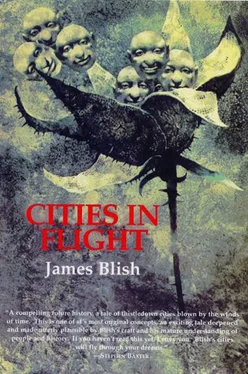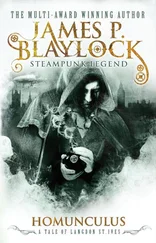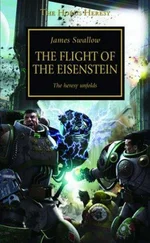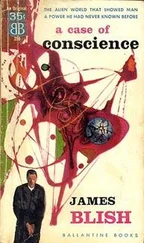James Blish - Cities in Flight
Здесь есть возможность читать онлайн «James Blish - Cities in Flight» весь текст электронной книги совершенно бесплатно (целиком полную версию без сокращений). В некоторых случаях можно слушать аудио, скачать через торрент в формате fb2 и присутствует краткое содержание. Жанр: Фантастика и фэнтези, на английском языке. Описание произведения, (предисловие) а так же отзывы посетителей доступны на портале библиотеки ЛибКат.
- Название:Cities in Flight
- Автор:
- Жанр:
- Год:неизвестен
- ISBN:нет данных
- Рейтинг книги:4 / 5. Голосов: 1
-
Избранное:Добавить в избранное
- Отзывы:
-
Ваша оценка:
- 80
- 1
- 2
- 3
- 4
- 5
Cities in Flight: краткое содержание, описание и аннотация
Предлагаем к чтению аннотацию, описание, краткое содержание или предисловие (зависит от того, что написал сам автор книги «Cities in Flight»). Если вы не нашли необходимую информацию о книге — напишите в комментариях, мы постараемся отыскать её.
Cities in Flight — читать онлайн бесплатно полную книгу (весь текст) целиком
Ниже представлен текст книги, разбитый по страницам. Система сохранения места последней прочитанной страницы, позволяет с удобством читать онлайн бесплатно книгу «Cities in Flight», без необходимости каждый раз заново искать на чём Вы остановились. Поставьте закладку, и сможете в любой момент перейти на страницу, на которой закончили чтение.
Интервал:
Закладка:
We find a similar passage in The Milky Way: Five Cultural Portraits:
Space flight had been a natural, if late, outcome of Western thought patterns, which had always been ambitious for the infinite. The Soviets, however, were opposed so bitterly to the idea that they would not even allow their fiction writers to mention it. Where the West had soared from the rock of earth like a sequoia, the Soviets spread like lichens over the planet, tightening their grip, satisfied to be at the bases of the pillars of sunlight the West had sought to ascend.
If we assume that the time stream of Blish’s universe separates from our own sometime around 1950, we will have no occasion to speak of sputnik. Even so, the question still remains whether the Soviets, or the Bureaucratic State, can be said to belong to a Spenglerian culture distinct from that of the West. In the first place, to say so is to reject Spengler’s view that Peter the Great succeeded in his Westernizing efforts, that Russia is therefore a part of the Western Civilization, and that communism is merely a continuance of Western influence [II, 192-96]. To be sure, Spengler believed that a new culture would be born in Russia in the near future (“to Dostoyevski’s Christianity [as opposed to Tolstoi’s] the next thousand years will belong” [II, 196]), but the Bureaucratic State can hardly be considered an expression of either Dostoyevski’s Christianity in particular or of springtime culture in general. In the second place, Spengler would surely reject the only reason offered by our future historians for considering the cultures distinct: that Russia differs from the West in not having “traditional libertarian political institutions”, for such institutions are neither universal in nor peculiar to the West but are instead the products, in every Spenglerian culture, of the fifth political epoch, Revolution and Napoleonism (see the table that appears with this essay). In predicting that the West will reach Caesarism by 2000, Spengler is predicting the end of such institutions in the West utterly without regard to any external conflict. All this being so, it follows that the great conflict between the “West” and the Soviets is simply a struggle between rival power blocs and that we must therefore regard the victory of the Bureaucratic State as establishing the Final Political Form of the Western Culture.
3. The Life Story of the Earthmanist Culture
The life of the Spenglerian culture begins with the birth of a “myth of the great style” [1, 339]. The new myth develops under two kinds of emphasis: that given it by the nobles and that given it by the priests. In the Western Culture, with its early rivalry between emperor and pope, the opposition between the emphases was very strong. For the Classical Culture the equally strong opposition has been largely obscured by the fact that only the military myth has survived in detail (e.g., in Homer). In the Arabian Culture, where the ruler was ordinarily both emperor and pope, the opposition was of little importance. In the Earthmanist Culture, where again only the military myth—the Vegan War—has survived in any detail, the opposition seems to be of even less importance in that the myth seems to have been overwhelmingly military rather than priestly. Even so, its purpose would seem to be primarily religious in that it has evidently developed as a means of relieving the Earthmen of a great burden of guilt.
The myth makes it appear that a small number of Earthmen were unaccountably able to prevail over a vast and enormously powerful “tyranny” which deserved to be completely destroyed. The fact must surely be that the Vegan Civilization was in the last stages of its Final Political Form with the concomitant “enfeeblement … of the imperial machinery against young peoples eager for spoil, or alien conquerors” [Spengler, I, Table iii; cf. the table with this essay]. Though outnumbered a million to one in total population, the Earthmen may well have been able to muster nearly as many fighting men as the Vegans at any given place and time, and they must have come into interstellar space with superior weapons or tactics or both—and with ferocity such as the Vegans had perhaps never experienced but for which there are precedents aplenty in the history of Earth, itself, the most cogent being perhaps the destruction wrought in Persia and Mesopotamia by the Mongols of Hulagu. And it was not only Vega II that felt the ferocity of the Earthmen, nor only the Vegans: “In 2394 one of the cities … was responsible for the sacking of the new Earth colony on Thor V; this act of ferocity earned for them the nickname of ‘the Mad Dogs,’ but it gradually became a model for dealing with Vegan planets”. In sum, at the close of the Vegan War the Earthmen had to choose whether they would be proud or ashamed of what they had done. Their shame brought about the trial of Admiral Hrunta—the great figure of the hundred-year war, its Agamemnon, its Charlemagne, its Arthur—for genocide; their determination to be proud resulted not only in the establishment of the Hruntan Empire but also in the birth of the Earthmanist Culture.
The attempts of the Bureaucratic State to bring Hrunta to justice culminate in the Battle of BD 40° 4048’, which is said to have been “indecisive”, but which is quite decisive in that it proves the State incapable of controlling more than a very limited volume of space. Since Hrunta’s empire is only “the first of many such gimcrack “empires’ … to spawn on the fringes of Earth’s jurisdiction”, we can put down the year of the Battle, 2464, as marking the beginning of the feudal order. Up to this time such Earthmen as have not been under the direct control of the Bureaucratic State have presumably been organized simply as tribes or war bands, each man acknowledging his military superiors only as temporary leaders and feeling loyalty only to the abstract concept of Earth; but now the temporary becomes apparently permanent, and loyalty finds concrete object in this or that leader or “emperor.”
In 2522 the Bureaucratic State collapses, the new Earth government proclaims a general amnesty, and the “Empty Years” begin; the Earthmanist Culture is thus free to develop in its own way. Admiral Hrunta is poisoned in 3089, and his death is followed by the “rapid Balkanization of the Hruntan Empire, which was never even at its best highly cohesive”; in 3111 Arpad Hrunta is installed as “Emperor of Space.” Here we seem to have the Interregnum which, according to Spengler, occurs in every culture and “forms the boundary between the feudal union and the class state” [II, 375]. Since Hruntanism is a religion as well as a dynastic principle, and since periods of religious reformation coincide with the transition from feudalism to the aristocratic state [II, 386], we are perhaps justified in listing Arpad Hrunta in our table as a religious reformer.
In an aristocratic state the king’s authority depends for its existence on the power of one or another of the aristocratic factions. The “absolute” state emerges when the king allies himself with the bourgeoisie and thus finds strength enough to suppress aristocratic disorder. In Earthmanist society as a whole, Earth is king, the various empires, duchies, and republics are the aristocracy, and the Okie cities are the bourgeoisie. Here the development into absolutism seems to culminate in 3602 with the “reduction” of the Duchy of Gort, the death of Arpad Hrunta, and the “dissolution of the Empire,” all brought about by the “recrudescent Earth police”, for we now have a galactic society in which the Earth police keep the spacelanes clear for Okie commerce. Since the Duchy of Gort represents an extreme form of Hruntanism, and since puritanism is a concomitant of the effort to preserve the aristocratic state [Spengler, II, 386n, 424], we can perhaps list the Duchy as an instance of puritanism.
Читать дальшеИнтервал:
Закладка:
Похожие книги на «Cities in Flight»
Представляем Вашему вниманию похожие книги на «Cities in Flight» списком для выбора. Мы отобрали схожую по названию и смыслу литературу в надежде предоставить читателям больше вариантов отыскать новые, интересные, ещё непрочитанные произведения.
Обсуждение, отзывы о книге «Cities in Flight» и просто собственные мнения читателей. Оставьте ваши комментарии, напишите, что Вы думаете о произведении, его смысле или главных героях. Укажите что конкретно понравилось, а что нет, и почему Вы так считаете.












